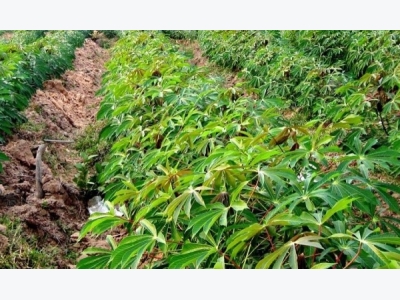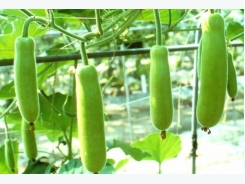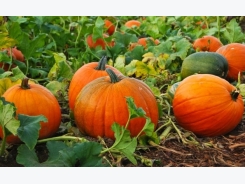Cassava Farming Information Guide

Introduction of Cassava Farming:- Cassava (yuca) is a starchy tuberous root of tropical perennial trees and used as food in tropical countries. The cassava plant is native to South America. The cassava crop was grown as alternative to rice, potato or corn (maize) in olden days. Nigeria in Africa is top production country of cassava in the world and Thailand is top producer of cassava in Asia. Cassava is an excellent commercial crop from which, food items, glucose, solvents, alcohol, animal feed, fertilizers, energy and others are produced.
The cassava tubers and leaves are the essential parts of cassava being used. Usually, cassava root is about one mm thick and brown colour on the outside. Generally, commercial cultivars are large in diameter and length. Cassava root flesh can be in yellow or white. Cassava is good source of starch and calcium, phosphorus, vitamin ‘C’. One can achieve desired profits in commercial farming of cassava with good cultivar and proper farm management practices. Generally, cassava crop is long term crop which may take 6 months to more than 2 years depending requirement stage. As cassava has lots of commercial uses, one can zero on the commercial farming of cassava. Let us discuss more in next paragraphs about cassava farming from planting to harvesting including health benefits of cassava.
Health Benefits of Cassava:- The following are the health benefits of cassava

Cassava Health Benefits.
- Cassava helps in weight management.
- Cassava is good for digestive system and may increase the apatite.
- Cassava prevents cancer cells growth.
- Cassava helps in treating diarrhea.
- Cassava is good for eye health.
- Cassava cures fever and headaches.
- Cassava may treat rheumatic diseases.
- Cassava heals wounds quickly.
- Cassava helps in clearing up worms.
- Cassava boosts immune power.
- Cassava is good for brain and nerve health.
- Cassava helps in lowering blood pressure.
- Cassava is good for skin and hair health.
Scientific Name of Cassava:- Manihot esculenta.
Family Name of Cassava:- Euphorbiaceae.
Common Names of Cassava:- Cassava, Mutumbula , Muthupula, Unjumbula.
Top 10 Cassava Production Countries:- The following are top 10 Cassava production countries in the world.
1. Nigeria
2. Indonesia
3. Thailand
4. Congo
5. Ghana
6. Brazil
7. Angola
8. Mozambique
9. Vietnam
10. India.
Local Names of Cassava in Other Parts of World:- Maniok (German), Cassave (Dutch), Moxog (Somali), Maniok jadalny (Polish),کٹ ات) Urdu), Maniok (Bosnian), Kamoteng Kahoy (Cebuano), Mandi’o (Estonian), Casabhaigh (Irish), 카사바 (Korean), Tarul (Nepali), Mandioca (Portuguese), тропска биљка(Serbian), Yuca (Spanish), كاسافا) Arabic),Маниока (Bulgarian), 木薯 (Chinese), Kamoteng kahoy (Filipino), Manihot esculenta (Italian), Maniok (Norwegian),มนั สําปะหลงั (Thai), Sắn(Vietnamese), キ ャ ッ サ バ (Japanese), Manioka (Latvian), Manyokka (Sinhalese), Tapioca (Czech), Manioc (French), Sakarkand (Hindi),маниока (Macedonian), Маниок (Russian), Maniok (Slovak), Maniok (Swedish), Manyok /Mandioko (Turkish), 木薯 (Cantonese), Kassava (Danish), Ubi kayu (Malay),مانيوک) Persian), 樹薯 (Taiwanese).
Varieties of Cassava:- Sweet and bitter are two main types of cassava out which sweet one is commonly cultivated variety due to its higher yields. There are many hybrid varieties developed for commercial purpose and available to specific to region. The common improved varieties are Golden Yellow, Katabang, Macan and Brasil.
Climate Requirement for Cassava Farming:- Cassava is a tropical short-day plant and requires a warm, humid climate. Temperature plays major role in cassava production. Cassava crop is very sensitive to frost and advised to grow in frost-free regions. The best cassava yield can be expected between 25 °C and 30 °C. When it comes to water requirement, cassava crop yields best when abundant water is provided. Though it can stand prolonged periods of drought, it requires minimum well-distributed rain fall from 600 mm (minimum) to 4000 mm (maximum).
Soil Requirement for Cassava Farming:- Cassava can be cultivated in most of the soils. However, deep sandy loam soils are best fit to grow the tubers. In very rich (fertile) soils, vegetative growth can be more than tuber growth. Well drained and fertile soil is good enough for getting higher yields in cassava farming. For controlling the soil acidic levels add 40 to 50 kg of lime/ha. The best soil pH for cassava is 5.5 to 6.5.
Land Preparation for Cassava Farming:- Land should be prepared in such a way that all the weeds should be removed and bring the soil to fine tilth stage. Use tractor for deep ploughing and make sure to give couple of ploughings for better friable soil. If the cassava crop is grown commercially, make sure to go for soil test to find out the micro-nutrient deficiency. It is recommended to fulfill the nutrient requirement by applying necessary fertilizers during land preparation. Organic matter such as cow dung should also take care of fertility of soil issues. Make sure to prepare the land with drainage system.
Propagation in Cassava Farming:- Propagation of cassava is done through from stem cuttings

Cassava Plantation.
Planting and Spacing Cassava Farming:- Cassava can be planted all around the year, However, make sure to have soil has good moisture for 6 months after planting the stem cuttings. The care must be taken while planting cassava plants to make sure the stem to be planted must be from a matured plant of a year old which has 30 cm long with 5-6 nodes from the bottom stem. Make hills in the range of 70 to 75 cm apart as part of land preparation. Make sure to dig a hole about 18 to 20 cm deep in each hill where the cuttings (stems) are to be planted. Make sure to plant the crop in morning or late evening times when whether is cool. There are three types of planting methods one can follow depending on the season. Cassava stems with ¾ cuttings length should be planted in the soil. The remaining ¼ should be covered with fine/top soil.
1. Horizontal: This method of planting is preferred during summer so that the plant will be kept moist.
2. Vertical: This method of planting is preferred during rainy days so that it will not rot if constantly wet.
3. Slanting: This method of planting is preferred between the two seasons mentioned.
Irrigation in Cassava Farming:- Cassava is drought tolerant crop. However, it yields more when proper irrigation is provided and constant moisture in maintained throughout its growth.
Manures and Fertilizers in Cassava Farming:- Cassava crop responds very well to organic manures and fertilizers. Cow dung or any other animal manure will be good for cassava farming. The N: P: K ratio in cassava farming is 60:90:120 kg/ha any other nutrient deficiencies like Calcium, S, Zn, and B should be incorporated.
Weed Control in Cassava Farming:- Controlling weeds are one of the major tasks in any crop for healthy growth plants and good yield or production. Weeds can be controlled by chemical or mechanical means. However, mulching is another natural process of controlling weeds. Mulch material like hay or plastic mulch can be used in cassava farming to control or prevent the weed growth at cassava plant base. Go for weeding when cassava crop is about 30 cm tall. Technically, after 4 weeks for planting. Weeding should be carried out after 1 or 2 months after the first weeding task. Earthing should be carried as well at the same time of weeding.
Inter-Crop in Cassava Farming:- To get an extra income, farmers can go for any short duration crops during initial years of cassava farming. Green gram or black gram or any other vegetable crops are ideal for inter cropping in cassava cultivation. If this options is considered, make sure to supply additional fertilizers/manures along with irrigation for inter crops.
Pests and Diseases in Cassava Farming:- Controlling of pests and diseases in any crop is one of the major tasks for good yield and quality.
Pests: The most common pests found in cassava farming are locusts, beetles, ants and aphids. However, rats, goats and wild pigs are dangerous in cassava farming
Control Measures: Contact your local agriculture department or horticulture department for better solutions in cassava farming.
Diseases: The most common diseases found in cassava farming are mosaic disease, bacterial blight, anthracnose and root rot.
Control Measures: Local horticulture department is best source of solution provider in cassava farming.
Note: Your local horticulture department or any research oriented agriculture university is good source for finding suitable solutions for controlling pests and diseases in cassava farming.
Harvest in Cassava Farming:- Usually, cassava crop will mature in 1 year after planting in the field. Manual pull is recommended to harvest the crop. Once the crop is harvested, make sure to wash well and dry. Actually, cassava can be marketed as fresh or dried.

Cassava Tubers.
Yield in Cassava Farming:- Well, yield depends on many factors and one can expect the yield based on cultivar, irrigation, climatic conditions, and farming practices. On an average one can obtain Yield of 20 to 25 tonnes /ha and above can be obtained with good agronomic practices and management.
Bottom Line in Cassava Farming:- Always choose sweet cassava as others are poisonous. The poison in cassava disappears during cooking, so, cooking cassava as suman is a safe way of eating cassava. Chopping, soaking in water, heating up to 60°C, and exposing in the sun may remove poisonous in cassava tubers. One can get huge profits in commercial farming of cassava with proper care and management.
Related news
Tools

Phối trộn thức ăn chăn nuôi

Pha dung dịch thủy canh

Định mức cho tôm ăn

Phối trộn phân bón NPK

Xác định tỷ lệ tôm sống

Chuyển đổi đơn vị phân bón

Xác định công suất sục khí

Chuyển đổi đơn vị tôm

Tính diện tích nhà kính

Tính thể tích ao




 Cauliflower Cultivation Information Guide
Cauliflower Cultivation Information Guide  Pumpkin Cultivation Information Guide
Pumpkin Cultivation Information Guide